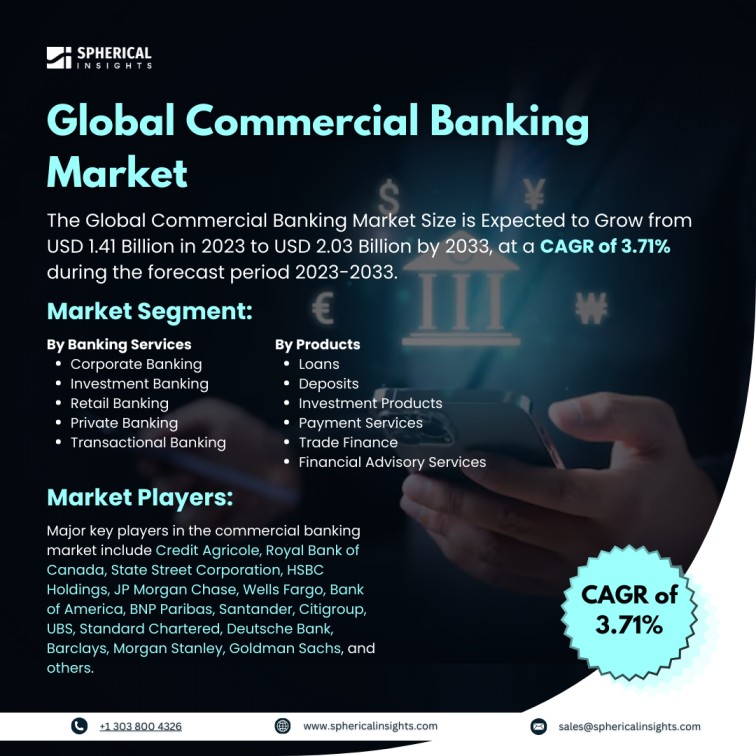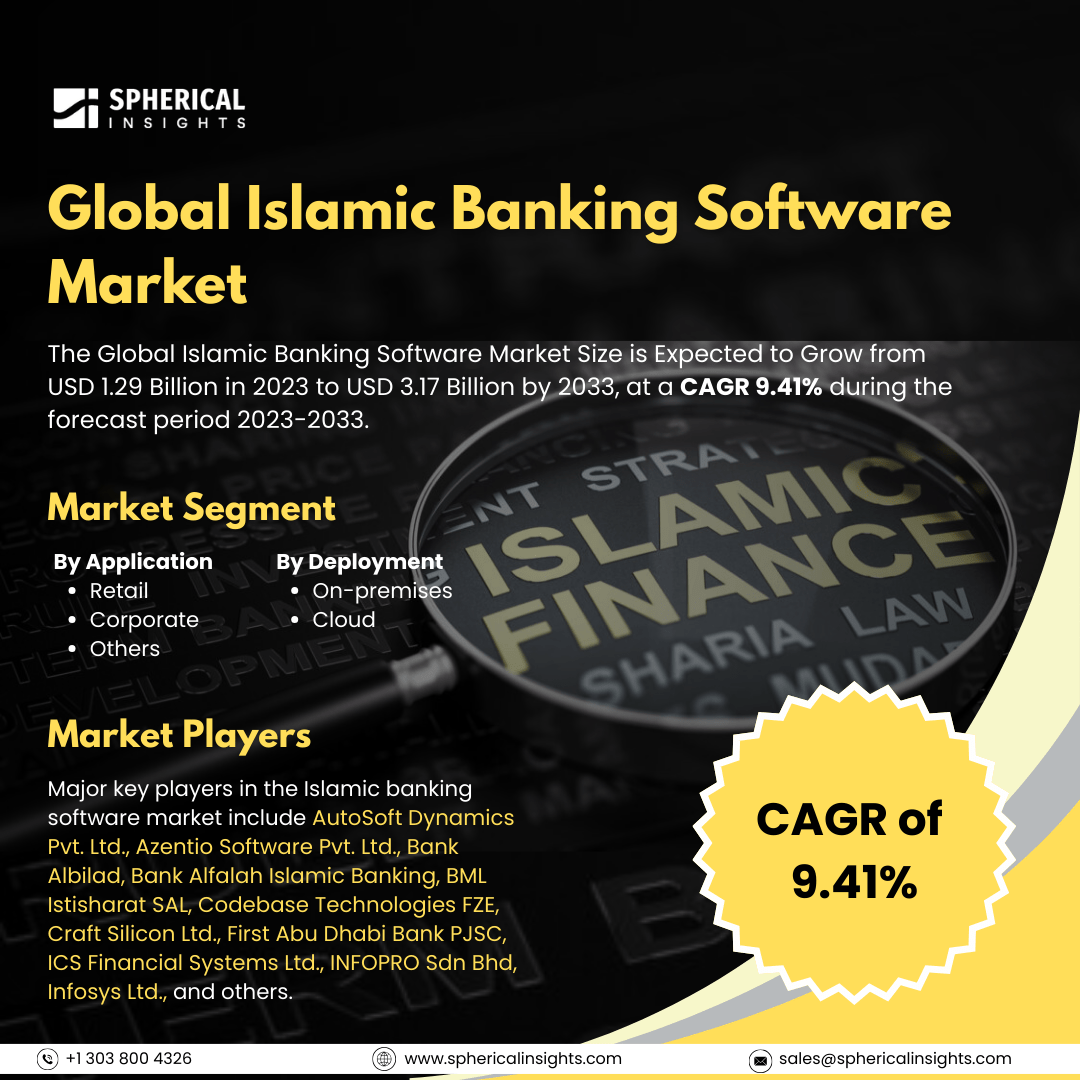Global Commercial Banking Market Size to worth USD 2.03 Billion by 2033
According to a research report published by Spherical Insights & Consulting, the Global Commercial Banking Market Size is Expected to Grow from USD 1.41 Billion in 2023 to USD 2.03 Billion by 2033, at a CAGR of 3.71% during the forecast period 2023-2033.
Browse key industry insights spread across 210 pages with 110 Market data tables and figures & charts from the report on the Global Commercial Banking Market Size, Share, and COVID-19 Impact Analysis, By Banking Services (Corporate Banking, Investment Banking, Retail Banking, Private Banking, and Transactional Banking), By Products (Loans, Deposits, Investment Products, Payment Services, Trade Finance, and Financial Advisory Services), and By Region (North America, Europe, Asia-Pacific, Latin America, Middle East, and Africa), Analysis and Forecast 2023 – 2033.
The commercial banking market encompasses the services offered by commercial banks, including loans, deposits, and financial advice. Commercial banks are financial institutions that primarily serve businesses, government agencies, and other large organizations. Several factors drive the commercial banking market. Technology plays a significant role in transforming the banking sector, enabling banks to achieve operational efficiency and gain a competitive edge. Additionally, the demand for banking services from consumers and small to mid-sized companies is a crucial factor. Economic growth can also affect bank profitability, while changes in policy rates and reserve requirements can impact interest rates. Other influences on profitability include credit risk, management efficiency, business diversification, and market concentration. However, there are various constraints on the commercial banking market. For instance, banks often require substantial collateral for loans, which some borrowers may be unable to provide. The risks of fraud and robbery can hinder the growth of the market. Furthermore, market risks can arise from the unpredictability of interest rates, commodity prices, equity markets, and credit spreads. Banks must also comply with regulatory demands and protect themselves from cybersecurity threats, all while navigating a constantly evolving digital landscape.
The retail banking segment is predicted to hold the largest market share through the forecast period.
Based on the banking services, the commercial banking market is classified into corporate banking, investment banking, retail banking, private banking, and transactional banking. Among these, the retail banking segment is predicted to hold the largest market share through the forecast period. The demand for personalized banking services among individual customers is increasing. This trend is driven by factors such as the growing adoption of digital banking solutions, rising disposable incomes, and a heightened focus on customer experience. Retail banks are responding by expanding their product offerings, which now include loans, savings accounts, and investment services. This broadens their appeal to consumers and reinforces their market position.
The loans segment is anticipated to hold the highest market share during the projected timeframe.
Based on the products, the commercial banking market is divided into loans, deposits, investment products, payment services, trade finance, and financial advisory services. Among these, the loans segment is anticipated to hold the highest market share during the projected timeframe. Contributing factors include low interest rates, government incentives, and increasing consumer confidence. Financial institutions are streamlining their lending processes through technology, making it easier for borrowers to access funds. This trend is supported by a growing middle-class population that is seeking financing for education, home purchases, and business expansions, solidifying the dominance of the loans segment in the market.
North America is estimated to hold the largest share of the commercial banking market over the forecast period.
North America is estimated to hold the largest share of the commercial banking market over the forecast period. With its established banking infrastructure and robust economic growth. The region features a high concentration of financial institutions, offering a diverse range of banking services that cater to various business needs. Moreover, advancements in fintech are improving operational efficiency and customer engagement within commercial banking. As businesses increasingly look for sophisticated financial solutions, North America’s commercial banking sector is well-positioned for sustained growth and market leadership.
Europe is expected to grow the fastest during the forecast period. The banking sector is evolving due to several factors, including regulatory reforms, technological innovations, and a shift towards digital banking. There is also an increasing emphasis on sustainability and green finance, which is attracting investment and fostering new banking models aimed at environmentally conscious consumers. Additionally, the rise of startup fintech companies is disrupting traditional banking services, leading to heightened competition and improved offerings. This dynamic environment positions Europe as a rapidly evolving market with considerable growth potential in the banking sector.
Competitive Analysis
Major key players in the commercial banking market include Credit Agricole, Royal Bank of Canada, State Street Corporation, HSBC Holdings, JP Morgan Chase, Wells Fargo, Bank of America, BNP Paribas, Santander, Citigroup, UBS, Standard Chartered, Deutsche Bank, Barclays, Morgan Stanley, Goldman Sachs, and others.
Key Target Audience
- Market Players
- Investors
- End-users
- Government Authorities
- Consulting And Research Firm
- Venture capitalists
- Value-Added Resellers (VARs)
Recent Development
- In September 2024, Wells Fargo & Company (NYSE: WFC) launched specialized Application Programming Interfaces (APIs) designed specifically for its Commercial Banking clients. This expansion of Wells Fargo’s API portfolio offers immediate access to real-time data, which can help increase sales, enhance liquidity, reduce credit risk, and lower expenses for floorplan and channel finance clients in various industries, including automotive, motorsports, outdoor products, and equipment, recreational vehicles, consumer electronics, appliances, and technology.
Market Segment
This study forecasts revenue at global, regional, and country levels from 2023 to 2033. Spherical Insights has segmented the commercial banking market based on the below-mentioned segments:
Global Commercial Banking Market, By Banking Services
- Corporate Banking
- Investment Banking
- Retail Banking
- Private Banking
- Transactional Banking
Global Commercial Banking Market, By Products
- Loans
- Deposits
- Investment Products
- Payment Services
- Trade Finance
- Financial Advisory Services
Global Commercial Banking Market, By Regional Analysis
- North America
- Europe
- Germany
- UK
- France
- Italy
- Spain
- Russia
- Rest of Europe
- Asia Pacific
- China
- Japan
- India
- South Korea
- Australia
- Rest of Asia Pacific
- South America
- Brazil
- Argentina
- Rest of South America
- Middle East & Africa
- UAE
- Saudi Arabia
- Qatar
- South Africa
- Rest of the Middle East & Africa



